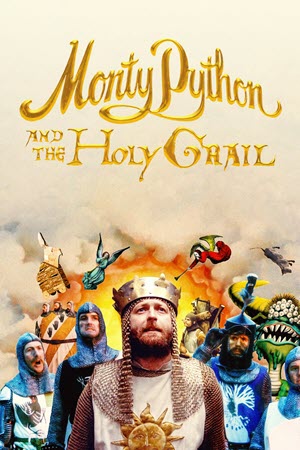Monty Python and the Holy Grail
 As noted elsewhere, I’m currently writing an academic paper about Spear, the Nicola Griffith novel based on the Mabinogion story of Peredur. Whenever one is discussing Peredur, it is necessary to also discuss the Holy Grail, even though that artefact never actually appears in the story. Later versions of the legend do include the Christian references, and these days they have taken over the narrative. And the most famous modern version of the story is undoubtedly the one featuring coconuts, anarchist peasants, and a great deal of running away.
As noted elsewhere, I’m currently writing an academic paper about Spear, the Nicola Griffith novel based on the Mabinogion story of Peredur. Whenever one is discussing Peredur, it is necessary to also discuss the Holy Grail, even though that artefact never actually appears in the story. Later versions of the legend do include the Christian references, and these days they have taken over the narrative. And the most famous modern version of the story is undoubtedly the one featuring coconuts, anarchist peasants, and a great deal of running away.
I can’t remember whether I have watched Monty Python and the Holy Grail before, but it turns out that it didn’t matter because I knew most of the dialog off by heart. People quote it so often that it has become part of the cultural background. I suspect that if you asked a lot of young people these days where the phrase, “I fart in your general direction” comes from, they’d have no idea. But they would be very familiar with the phrase, and probably even know that it should be said in a very bad mock-French accent.
However, I was not watching the film to consider its impact on Western culture, I was interested in its relationship to Arthuriana.
When you ask a question like that, you also have to ask what period of Arthuriana you are looking at. Is it The Mabinogion, Geoffrey of Monmouth, Thomas Mallory, Tennyson, TH White, Disney? Each age re-invents the Arthur story for itself. As it turns out, the Python version is a bit odd. It claims to be set in the 10th Century, which is both too late to see much in the way of actual resistance to Saxon rule of the Eastern part of Prydain, and too early for the cod-mediaeval idea of knighthood that the film uses.
Mostly the film is making fun of the view of mediaeval life that was common when it was made (and not that different from the one in A Song of Ice and Fire). Lancelot’s excessive violence and Galahad’s struggles with his chastity sound more Mallory to me than anything else. Miraculously the character of Tim the Enchanter manages to poke fun at John Boorman’s Excalibur even though the Python film was released 6 years earlier. But there are a couple of places where the film digs deeper.
Firstly there is the landscape. A defining feature of Arthurian landscapes is that they are vast wildernesses punctuated by castles. There is little evidence of any society outside of the castles and their inhabitants. And, as in A Song of Ice and Fire, there is little sign of any economic activity that could finance the knights and their wars. Dev Patel’s Sir Gawain and the Green Knight illustrates this well, and so does the Python film.
My favourite part of the film, however, is the encounter with the Knights Who Say “Ni!”. They live deep in the forest. Michael Palin’s character as the head night, with his vast height and antler-crowned helmet, is very Celtic. And while I don’t think there is any mention of shrubberies in The Mabinogion, I can quite imagine one of Arthur’s men being asked to chop down a tree with a fish (probably a salmon rather than a herring), and somehow succeeding in the quest. In part because it has come down to us via Christian monks and dodgy English translations, The Mabinigion is often a very silly place.